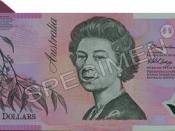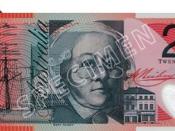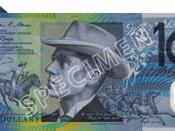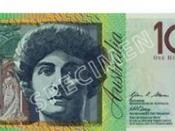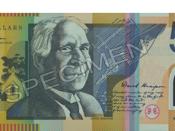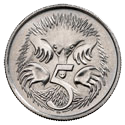Good morning...
Today I will be talking about the fluctuations in the Australian dollar by some of the major domestic and international events.
'The Australian dollar is the currency of the Commonwealth of Australia, it is currently the fifth-most-traded currency in the world foreign exchange markets, accounting for over 6% of worldwide foreign-exchange transactions. The Australian dollar is a commodity dominated currency and is popular with currency traders due to high interest rates in Australia, a relative lack of central bank intervention, the general stability of the economy and government, and it lends greater exposure to Asian economies and the commodity super cycle.'Increase in globalisation and the dollar becoming free floating, has led the Australian dollar to been heavily influenced by international factors. These include overseas interest rates, upward and downward movements of global stock markets, levels of global growth and demand and lastly the level of overseas confidence. An example of this would be the 2007 market crash in the U.S.
which affected international stock markets. The Reserve Bank of Australia's contractionary stance over 2007 had caused the Australian Dollar to reach 23 year high against the U.S. Dollar.
The Australian Dollar now relies on its commodity export such as gold, copper, coal and wool. 'These commodities now account for 1 billion Australian Dollars which is 55 percent of total export. Any changes within the market for commodities will affect the movement of the Australian Dollar.' Over the past 15 years, the Australian Dollar has been growing throughout the economic cycle and has come across many opportunities in world trade. China, Asia's great economic engine has been growing above 8 percent per annum and demand for Australian commodities has been high. Australia also has the world's largest reserves of uranium, which is another economic opportunity as the world begins to address the issues such as the global energy crisis.
The Australian Dollar is also influenced by domestic factors. These include, level of interest rates, level of economic growth and other economic indicators such as inflation. The Reserve Bank of Australia can also influence the level of exchange rates during times of instability, by buying and selling currencies.
Currently in 2009, there is two major effects on the Australian dollar. One - foreigners that import Australian goods and services must buy the local currency to pay for the nation's exports. Two - the amount of exports the nation is producing says a lot about its economy, and investors are fairly wise to know how to understand these figures. It means that investors are more likely to invest their funds in countries that have better exporting data, and therefore create more demand for the local currency, and this has a direct impact on the value of the currency.
Therefore, if Australian exports are in high demand, there will also be a high demand on the currency to pay for the exports, these demand pressures cause the value of our dollar to rise. The opposite occurs if the demand for exported goods decline.
This is one of the reasons why the effectiveness of Reserve Bank intervention in the foreign exchange market is becoming less as financial markets expand. While the Reserve Bank can probably be quite effective at pushing the Australian dollar down by selling the currency, it is very limited in pushing it up. The RBA only has its limited foreign reserves to buy the Australian dollar. The amount of Australian dollars traded in one day in Australia's foreign exchange market exceeds its total foreign reserves.
So now we know some of the impacts of the Australian dollar, now the question; where does the Australian dollar stand today in 2009 and what are its forecasted values?Back in July 2008, everyone was talking about how the Australian dollar could reach the same rate as the US dollar. At the time, the currency pair was trading at 0.9845 a 20 year high. However what rises quickly can also fall quickly because when commodity prices peaked in July the Australian dollar came crashing down. The currency fell close to 40 percent against the US dollar to a 5 year low before finding support above 60 cents. The move was even more dramatic against the Japanese Yen, it traded as high as 104 yen earlier this year before it dropped to a record low. Despite the dramatic moves, the Australian dollar's weakness was not universal. Since the beginning of the year, the currency actually strengthened against the British pound and New Zealand dollars. These currency fluctuations are particularly important because Japan, China and the US are the largest export destinations for Australia and a weaker currency reduces the costs for exports.
China in particular, has been the heart of global growth in Australia for the past 10 years, but unfortunately for Australia. China has started to feel the global slowdown. The biggest exports to China have been iron ore from Australia, to go on to be made into steel in China. These imports over the years caused the Australian dollar to sky rocket up and stability along with high economic growth was experienced by the Howard government. Now I will show you this video about the current situation between China and Australia and the importing of iron ores.
So as seen in the video the demand for steel in China has decreased and that has caused imports of raw materials from Australia to heavily decrease. This is sure to impact our dollar in a negative manner.
Keeping this in mind, recently reports have shown that China has signed a $50 billion gas contract with Australia for over two decades. This is the largest export contract ever experienced in Australia and is showing positive forecasts all around for the value of our dollar.
But now the question comes, was this high appreciation of the Australian dollar and any more appreciations in the future a good sign for the primary industries of Australia such as, our local farmers. As mentioned before, if our exports increase by a large amount causing our dollar to rise, our local farmers will have a hard time exporting their produce to overseas countries since the price for local goods will increase. I myself work in a produce section and have seen more and more imported goods being brought onto our shelves because local goods are now just too expensive. Appreciations in the dollar can also cause domestic inflation in our economyThe answer to this question is - Yes, an appreciation in our dollar is a good factor for the Australian economy, but needs to be controlled. As the dollar rises, government intervention is a very important factor. The government can control how much exports leave the country and can also increase import duties and taxes so our local farmers can benefit from local buyers. Also the government can control the problem of inflation by varying the interest rates. Another solution to control the appreciation of our dollar is the selling of currencies by the reserve bank, which will bring the dollar down if need be.
Summarising the fluctuations in the Australian dollar in 2009, it can be concluded that when funds flow into the US then tend to flow out of Australia and the Australian dollar falls. When there is uncertainty in the US markets, investors seek out Australia and other relatively stable economies, and the Australian dollar rises. Major trading countries such as China, could also have a major impact on the dollar if demand declined on large levels. Interest rates and future expectations also continue to play a part in determining the level and direction of the dollar.
Bibliography1.Guy Woods, 18 September 2008, Economic Indicators on the Internet,(Online) available: http://www.aph.gov.au/library/INTGUIDE/STATS/ecindicators.htm#(Accessed 27.03.09)2.Ross Gittins, August 8, 2007, Interest rates rise,(Online) available: http://www.smh.com.au/news/business/interest-rates-rise/2007/08/08/1186252744199.html(Accessed 9.04.09)3.(Author not available) May 5, 2009, Rudd defends spending as Budget looms(Online) available: http://au.biz.yahoo.com/090511/31/2695c.html(Accessed 5.05.09)4.(Author not available) 06.04. 2009, Household Stimulus Package(Online) available: http://www.centrelink.gov.au/internet/internet.nsf/individuals/bonus_payments_feb2009.htm(Accessed 8.04.09)5.(Author not available),14 October 2008, Joint Press Release with, the Treasurer, Wayne Swan, Economic Security Strategy(Online) available: http://www.pm.gov.au/media/release/2008/media_release_0550.cfm(Accessed 12.04.09)6.(Author not available), November 7th, 2007,Interest rate rise in Australia- be prepared for more to come(Online) available: http://cij.inspiriting.com/?p=307(Accessed 28.04.09)7.Jessica Irvine, November 7th, 2007, RBA lifts interest rates(Online) available: http://www.smh.com.au/news/business/interest-rates-rise--again/2007/11/07/1194329262255.html(Accessed 28.04.09)
